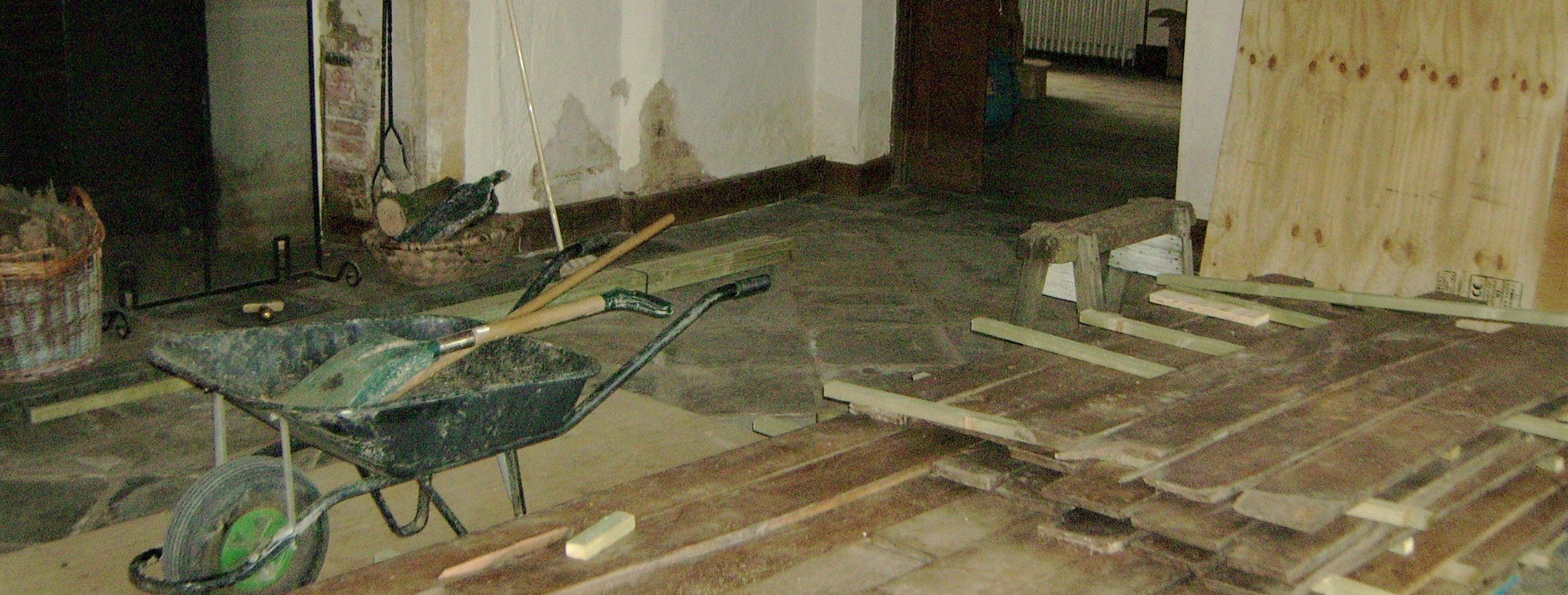After a Flood
If you're unfortunate enough to suffer a flood, this page can help you to plan recovery and minimise flood damage in a historic home.
Practical advice on what to do after a flood is available from the Know Your Flood Risk Campaign. Their Flood Recovery Guide provides helpful information on the initial stages of flood recovery.
Planning flood recovery work
If your home's insured, the insurer's loss adjuster will most likely inspect it and they may bring in a surveyor to establish and specify the extent of repair works needed. A ‘recovery contractor’ appointed by the insurers would then be brought in for any necessary decontamination work and to dry the property. A separate contractor may be brought in for the building repair works.
Historic buildings can be particularly vulnerable at this stage as potentially damaging works may be specified, involving extensive removal of historic material. The appointed contractor may have little or no experience of working on historic buildings and use incompatible materials for the repairs.
Our advice is:
- Make a comprehensive photographic/video record of the damage
- Tell your insurance company that you need a loss adjuster/recovery contractor with experience of older buildings to prevent unnecessary damage
- If your building's listed, get advice from the local planning authority to establish whether you need listed building consent before any stripping out work or repairs start
- Get independent advice from a conservation accredited architect or surveyor who has experience of older buildings, and who may know local contractors suited to this type of work
- Beware of bogus contractors who can take advantage of flood victims
- Do not remove lime plaster from walls. Research has shown that this does not help walls to dry out more quickly
- Do not strip out old timber floors. Timber in historic buildings is usually of a higher quality than new timber. Old timber floors can be cleaned and will dry out relatively quickly if you can maintain the right environmental conditions
Drying out
Ideally repairs and drying can start as soon as is practical after dealing with any contamination issues and making the building safe. Decontamination isn't always an issue as it depends on the nature of the flooding.
- Basements and sub-floors can be pumped out when flood waters have receded to a safe level
- Remove damp items and sodden floor coverings. If left, they'll slow drying and trap moisture, encouraging mould growth and decay. Contaminated items will need cleaning if they're viable
- Move large items of furniture away from walls, and open cupboards or voids to encourage drying. Dry rot and other decay problems won't occur provided that drying proceeds and moisture doesn't become trapped. The removal or treatment of timber items in case they decay at a later time is unnecessary
- Removing timber panelling, staircases, floors or lime plaster may be unnecessary and could cause unacceptable damage to the building. If you're in any doubt about your listed building, consult your local planning authority/conservation officer. Historically important materials should only be removed by craftspeople with appropriate skills and experience and thought should be given to appropriate storage and recording
- Open doors and windows and maximise the air flow with fans or blowers. Quadrupling the air flow across a surface doubles the rate of drying and discourages mould growth
- Heat and forced air movements should only be used if there is significant ventilation. Otherwise, warm humid air will be dispersed around the building causing potential secondary damage in the form of condensation and mould growth elsewhere
- Dehumidifiers can be useful at the start of the drying process. Continued use of dehumidifiers may only produce superficial drying
- Rapid drying can be damaging to historic fabric
- Meters and data loggers recording temperature and relative humidity can be useful for monitoring the progress of drying, but take care when interpreting the data. There can be large variations in the moisture levels in different buildings, and in older buildings normal ‘dry’ moisture levels may be higher than in modern buildings
- Application of new plaster and wall finishes should be avoided until a wall is thoroughly dry, which could take at least 12 months, as salts may come to the surface if there are still pockets of wet material. Moisture distribution within a wall is highly variable and damp patches aren't easy to locate
- Try to keep a detailed photographic record of every stage of the flood damage and subsequent drying and repairs
- Repair works after a flood can be a good opportunity to build in flood resilience measures so that if the property floods again, damage can be minimised. For example, consider whether damaged plaster could be reinstated with flood-resilient lime plaster, rather than gypsum plaster. See our page on protecting your home from flooding and flood damage for more flood-resilience measures
Our guidance Flooding and Historic Buildings goes into more detail on:
- Initial drying, decontamination and cleaning, including
- Safety checks
- Structural issues
- Reconnecting services
- Drains and sewers
- Salvaging detached and damaged items
- Security
- Assessing and recording damage
- Drying out
- How flooding affects historic building materials
- Concrete
- Earth construction
- Structural timber
- Timber panelling, floor boards, doors, staircases
- Render and plaster
- Metalwork and ironmongery
- Wallpaper, paint and wall painting
- Monitoring the long-term effects
- Further sources of advice and information





